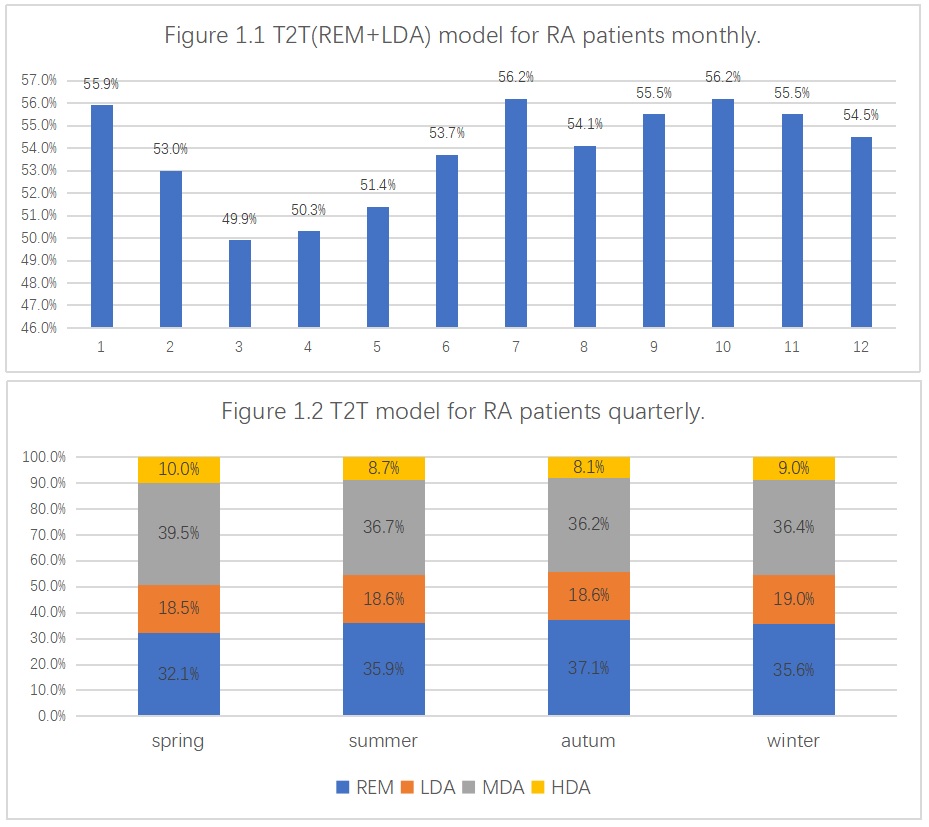Session Information
Date: Sunday, November 8, 2020
Title: Epidemiology & Public Health Poster III: Inflammatory Rheumatic Disease
Session Type: Poster Session C
Session Time: 9:00AM-11:00AM
Background/Purpose: Treat-to-Target(T2T) is the main therapeutic strategy for patients with RA and SLE. There has been no report on comparation of seasonal variations on T2T rates in patients with RA and SLE.
Smart System of Disease Management (SSDM) is a smart phone-based mobile disease management tool, equipped with two apps, one for doctors and one for patients. After training by health care professionals, rheumatic patients will download and use SSDM for DAS28 or SLEDAI-2000 self-assessment, and upload clinical data (including disease activity,medication status and laboratory test results) to SSDM cloud, meanwhile the data will be synchronized to authorized physicians. Based on the clinical data submitted by the patient, the doctor can respond to the patient’s request of consultation and refill the medication.
The purpose of this study was to outline and compare the effect of seasonal variations in the T2T rates through analysis of self-reported disease activity data in patients with RA and SLE from the SSDM system.
Methods: Seasons were designed as following: Spring is from March to May, summer from June to August, autumn from September to November, and winter from December to February.
DAS28 and SLEDAI-2000 data from each individual patient was extracted from cloud, and then pooled for analysis according to seasonal definition. DAS28≤3.2 and SLEDAI-2000≤4 are considered to be the criteria for achieving “T2T” for patients with RA and SLE, respectively.
Results: Between June 2014 and June 2020, 1,944 doctors from 632 hospitals in China joined the study, and 127,316 DAS28 assessments were conducted by 56,546 (male 10,260, female 46,286) RA patients (mean age 51.35 ±14.13 years, median course of disease 45.97 months), and 42,593 SLEDAI-2000 assessments were conducted by 19,629 (male 1,419, female 18,210) SLE patients (mean age 37.45 ±12.34 years, median course of disease 48.73 months)
The T2T rate of RA patients in spring is the lowest among four seasons in consecutive 5 years (mean rate of T2T is 50.5%, with 49.9% in March, 50.3% in April, and51.4% in May), while the average T2T rate in summer, autumn, and winter is 54.6%, 55.7%, and 54.5% respectively, with a U-shaped distribution from January to July. There is no significant difference in the overall distribution for SLE T2T rates among the four seasons. The T2T rates in spring, summer, autumn and winter were 55.8%, 55.5% ,56.7% and 57.3% respectively. However, there were two significant monthly drops on T2T rates in March (53.6%) and August (53.9%).
Conclusion: To our knowledge, this is the first study of outlining and comparing seasonal variation of T2T rates in patients with RA and SLE. Self-reported clinical data in SSDM for consecutive 5 years showed that RA patients have the lowest T2T rate in the spring season, which corelated with super long holiday of Chinese New Year, while SLE patients have the lowest T2T rate in March and August, which matched with holiday and strong UV light irradiation, respectively.
 Figure 1. T2T model for RA patients (1.1 monthly;1.2 Quarterly)
Figure 1. T2T model for RA patients (1.1 monthly;1.2 Quarterly)
 Figure 2. T2T model of SLE patients (2.1 monthly; 2.2 Quarterly)
Figure 2. T2T model of SLE patients (2.1 monthly; 2.2 Quarterly)
To cite this abstract in AMA style:
Wu L, Da Z, Wang H, Huang J, Wu B, Wu H, He F, Wang F, Du R, Su L, Yao Q, Wu R, Li Z, Wang X, Liu Y, Li C, Lei X, Wang M, Xiao H, Jia Y, Liu Y, Chen X, Jia S, Wu B, Liu Y, Xiao F, Dong L. Seasonal Variation in the Treat-to-Target Rate of Rheumatoid Arthritis (RA) and Systemic Lupus Erythematosus (SLE): A Cohort Study on Self-reported Data from Smart System of Disease Management (SSDM) [abstract]. Arthritis Rheumatol. 2020; 72 (suppl 10). https://acrabstracts.org/abstract/seasonal-variation-in-the-treat-to-target-rate-of-rheumatoid-arthritis-ra-and-systemic-lupus-erythematosus-sle-a-cohort-study-on-self-reported-data-from-smart-system-of-disease-management-ssdm/. Accessed .« Back to ACR Convergence 2020
ACR Meeting Abstracts - https://acrabstracts.org/abstract/seasonal-variation-in-the-treat-to-target-rate-of-rheumatoid-arthritis-ra-and-systemic-lupus-erythematosus-sle-a-cohort-study-on-self-reported-data-from-smart-system-of-disease-management-ssdm/
